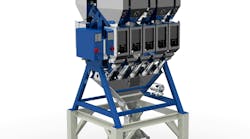Few plastics processing plants have embraced assembly operations as fully as Sanmina Corp.’s injection molding facility in Turtle Lake, Wis. The plant operates 73 injection molding machines with three eight-hour shifts, five days a week.
The plant employs six automation engineers who design, fabricate and troubleshoot all assembly and robotic equipment used throughout the plant. The plant also offers manual assembly, welding and adhesive bonding.
“We do everything from simple to complex,” GM Scott Schoenborn said. “It could be as simple as putting together a couple of components manually, or as complex as putting plastic components that we mold here into circuit boards made at our sister facility to manufacture a complex part.”
The plant also tests the circuit boards.
“The testing also ranges from simple to complex,” Schoenborn said. “We use lasers to test speakers for the distance and direction the sound travels. The assembly and testing are diverse because our customers are diverse.”
Sanmina also is diverse. The publicly traded electronics manufacturing services company is based in San Jose, Calif., and has about 45,000 employees. It has 75 facilities in 25 countries.
Speaker assembly is done with metal brackets and screws from an outside vendor, Schoenborn said. It takes 60 to 75 seconds to assemble the speakers but only a couple of seconds to test them.
About 70 percent of assembly operations are manual and the rest are performed by robots or by simple automation.
“What drives the assembly, whether it’s manual or by robot, is what the customer is trying to achieve and at what cost point,” he said. “What investment does the customer have for their platform to get the return on investment that they need?”
Customer input on assembly is welcome.
“We love it when the customer is involved,” Schoenborn said. “It gives us more information and guidance on what they want to achieve.”
He described one project where the company had 12 people on an assembly line that produced 90 units per hour. After working with the customer, the company added some robotics to the process and reduced the assembly operation to four people producing 120 units per hour.
“We were able to do that because the customer got involved with the desired outcome and we fine-tuned the process. They told us what they wanted to achieve with the budget they had. We met their budget and improved the process. It’s fun when the customer gets involved.”
Sanmina approaches assembly analytically.
“We often start with operators doing manual assembly,” Schoenborn said. “We will take an entire assembly line and isolate it by task and look for repetition. Sometimes we videotape the manual assembly. We look at what investments can be reasonably made to automate the tasks. This helps us understand the scope of work and identify where it would be most productive to invest in automation.”
Sanmina invests in automation and robots, resources that can be applied to multiple projects.
“We own the robots and fit them into various assembly operations,” Schoenborn said. “The automation that we design and build is an expense to the customer. We can reconfigure the robots that we are using to do different things. One example is if a robot cell is putting on serialization labels, we will have a camera system and a big turntable. If the customer doesn’t want labels anymore, if they want to hot-stamp it with no vision system but instead have an auto-bagger system, we can do that in very little time using the same robot. If the customer wants to do different things, we can change quickly and reuse the automation. We need to react quickly to changing customer needs.”
Assembly almost always is done onsite at the plant with Sanmina employees.
“We try to keep everything in-house,” Schoenborn said. “The only time we would move offsite is if we needed large turntables that we can’t machine on our own equipment. Since our molding department runs three shifts a day, five days a week, we interchange operators with assembly.”
One key to success is getting the right team in place that can work with customers to understand their needs and quality requirements, he said. It’s also important to resist the temptation to over- automate, which can increase costs.
“Provide the most economical solution to meet their budget and their quality needs,” Schoenborn said. “Your first investment is in people. After that, you still have to put together a robust solution that is predictable, dependable and always meets their quality requirements.”
Due to its large size, related manufacturing capabilities and other resources at Sanmina, the plant enjoys certain built-in competitive advantages when it comes to assembly.
“We have a lot of company attributes, such as the support of our global sourcing managers,” Schoenborn said. “We get printed circuit boards and cable assemblies from our sister facilities that we add to and assemble. We have tons of machining capabilities in our Fremont, Calif., plant and in other sister plants. I also have some very innovative automation engineers who focus on customers. It all comes together very nicely when you have the structure to support it.”
Bruce Adams, senior staff reporter





